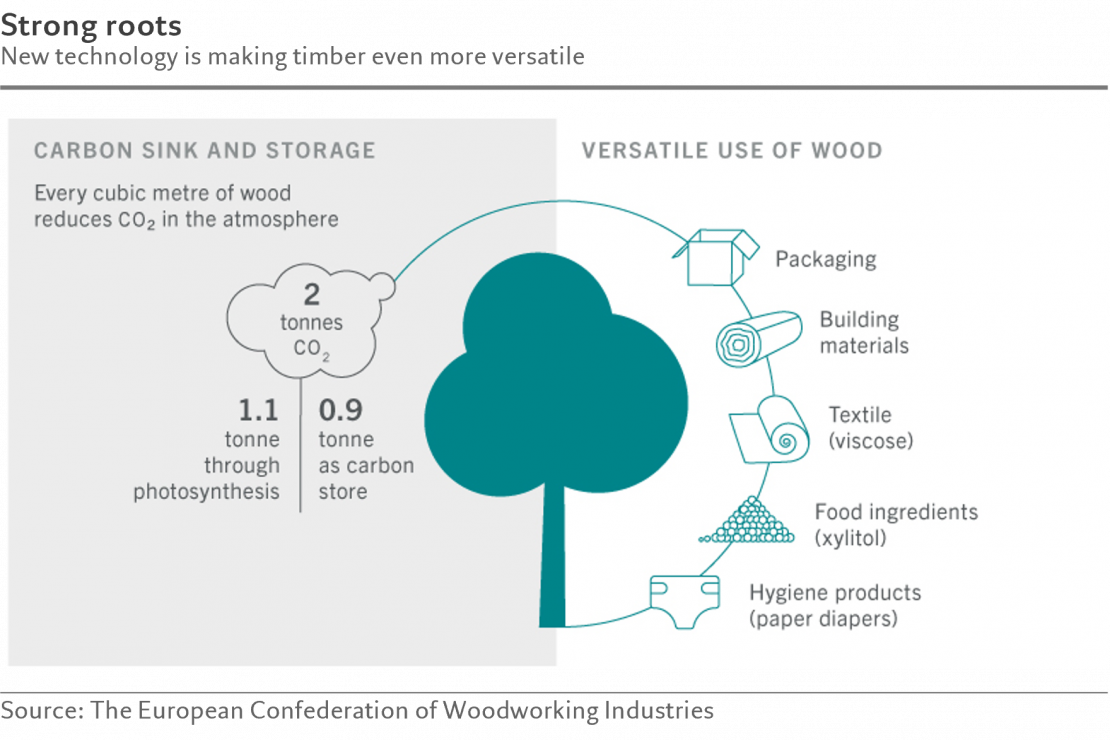Every day, the world’s urban population swells by 200,000. At that rate, more than two thirds of us will be living in cities by 2050 compared with just over half today1.
That will require a significant expansion of the built environment. It could also mean a significant enlargement of humans’ carbon footprint. Cities already account for around three quarters of global carbon emissions and energy use2. This means using popular construction techniques and planning methods would likely derail efforts to halt climate change.
But it need not be this way. Participants attending The Klosters Forum showcased the ways in which the looming urban expansion could yet be sustainable. Not all the solutions were technologically advanced. The most effective, attendees discussed, literally grows on trees.
Timber has strong credentials as a sustainable building material. Historically, timber has been used in building construction for centuries across Asia, Europe and Americas thanks to its durable and resilient properties and relative ease of construction.
In recent decades however, the material’s share in building has shrunk in the face of concrete and steel which are considered more durable, rot resistant and easy to mass produce.
Wood for good
In a workshop on “how to scale timber buildings that regenerate sustainable forestry and local economies,” The Klosters Forum participants stressed the need to readopt this earliest method of construction en masse, especially if the world were to halt global warming and environmental degradation.
Timber provides an attractive cost-effective means to reduce net carbon emissions, especially the embodied carbon that the building sector badly needs0 to cut.
What’s more, it also acts as carbon sink, can restore biodiversity and improve soil quality.
There’s no shortage of data to support timber’s utility. For example, research shows a young willow tree building up a dry biomass of 75kg in the first five years of growth captures 140kg of CO2,3 which compensates the emission from a typical household’s electricity use for 10 days.4
Wood sequesters carbon even after it is logged. Every cubic metre of wood used as a substitute for steel or aluminium reduces carbon emissions to the atmosphere by an average of 0.9 tonnes.5 Proper forest management ensures timber is sourced sustainably without depleting forests.

Busting the myths
The key challenge, forum participants agreed, lay in formulating strategies that could incentivise the construction of timber-based buildings and regenerate sustainable forestry and local economies.
One of the myths surrounding timber is that it is not fit for tall buildings. However, mass timber is beginning to be used more widely for high-rise buildings, thanks to innovation.
Among the pioneering engineered wood products is cross-laminated timber (CLT) – a building panel made of sawn, glued and layered wood which allows architects to build wooden skyscrapers.
Mjøstårnet, currently the world’s tallest timber building in Norway, which rises to more than 85-metre high, uses CLT. A 100-metre-tall timber residential block is currently planned in Switzerland for completion in 2026.
The market for CLT is expected to grow to a USD2.5 billion globally by 2027 from the current USD1.1 billion, an annual increase of some 15 per cent6.
Another misconception is that timber-based buildings pose a fire hazard. However, wood is inherently fire resistant – when the external layers of a timber beam char, they protect the core from damage for longer periods. What is more, new technologies such as CLT can produce a stronger and fire-resistant weave which can outperform unprotected steel structures in fire safety.
Built by Nature, an Amsterdam-based organisation dedicated to showcasing ground-breaking projects, has been making multi-million euro grants to foster mass timber construction in cities.
“There are a lot of myths about mass timber – whether it’s inflammable or contributes to deforestation for example. There are a lot of research that speak the contrary and it’s important to distribute them and dispel these myths,” its CEO Amanda Sturgeon, a participant, said.
Forum attendees discussed the lack of technical knowledge in the public sector and municipal authorities. To overcome this challenge, forum attendees suggested that the industry should train sustainability facilitators to engage with this tough group of stakeholders.
They added that regulation and tax schemes should also change to reward environmental performance of buildings to induce system-wide change.
Encouragingly, some European governments are pledging a greater use of timber and other sustainable materials to meet national or municipal net zero targets. The city of Amsterdam is mandating that 20 per cent of all new construction projects to use wood or other biobased materials from 2025.
The French government is requiring all new public buildings to be made at least 50 per cent from wood or other sustainable materials from this year.
Typically, residential buildings in Europe use around 20 per cent of timber; this number drops to just 5 per cent for commercial counterparts7.
“Policies and mandates have to come into play to move the sector at speed we need,” Sturgeon said.
Notes
[1] UN World Urbanisation Prospects
[2] Seto et al. 2014; UN-Habitat, 2011
[3] Zuercher, Bern University
[4] US EPA
[5] European Confederation of Woodworking Industries
[6] Markets and Markets
[7] Tomorrow’s Timber
Read more about building a climate-resilient future through real estate
“What is The Klosters Forum?
The Klosters Forum is a not-for-profit organisation, offering a neutral platform for disruptive and inspirational minds to tackle some of the world’s most pressing environmental challenges. Its mission is to accelerate positive environmental change by developing and nurturing a growing community of leading thinkers and doers and by fostering cross-disciplinary exchange and collaborations.
Every year, the Forum hosts an environmental annual event connecting high-profile participants from the fields of science, business, politics and industry, as well as NGOs, creative minds and sustainability experts in a neutral and discreet environment. This year, the annual forum took place on 28-30 June 2022 with the theme “The future of the built environment.”
Information, opinions, and estimates contained in this document reflect a judgment at the original date of publication and are subject to risks and uncertainties that could cause actual results to differ materially from those presented herein.
Important notes
This material is for distribution to professional investors only. However, it is not intended for distribution to any person or entity who is a citizen or resident of any locality, state, country or other jurisdiction where such distribution, publication, or use would be contrary to law or regulation.
The information and data presented in this document are not to be considered as an offer or sollicitation to buy, sell or subscribe to any securities or financial instruments or services.
Information used in the preparation of this document is based upon sources believed to be reliable, but no representation or warranty is given as to the accuracy or completeness of those sources. Any opinion, estimate or forecast may be changed at any time without prior warning. Investors should read the prospectus or offering memorandum before investing in any Pictet managed funds. Tax treatment depends on the individual circumstances of each investor and may be subject to change in the future. Past performance is not a guide to future performance. The value of investments and the income from them can fall as well as rise and is not guaranteed. You may not get back the amount originally invested.
This document has been issued in Switzerland by Pictet Asset Management SA and in the rest of the world by Pictet Asset Management (Europe) SA, and may not be reproduced or distributed, either in part or in full, without their prior authorisation.
For US investors, Shares sold in the United States or to US Persons will only be sold in private placements to accredited investors pursuant to exemptions from SEC registration under the Section 4(2) and Regulation D private placement exemptions under the 1933 Act and qualified clients as defined under the 1940 Act. The Shares of the Pictet funds have not been registered under the 1933 Act and may not, except in transactions which do not violate United States securities laws, be directly or indirectly offered or sold in the United States or to any US Person. The Management Fund Companies of the Pictet Group will not be registered under the 1940 Act.
Pictet Asset Management (USA) Corp (“Pictet AM USA Corp”) is responsible for effecting solicitation in the United States to promote the portfolio management services of Pictet Asset Management Limited (“Pictet AM Ltd”), Pictet Asset Management (Singapore) Pte Ltd (“PAM S”) and Pictet Asset Management SA (“Pictet AM SA”). Pictet AM (USA) Corp is registered as an SEC Investment Adviser and its activities are conducted in full compliance with SEC rules applicable to the marketing of affiliate entities as prescribed in the Adviser Act of 1940 ref.17CFR275.206(4)-3.
Pictet Asset Management Inc. (Pictet AM Inc) is responsible for effecting solicitation in Canada to promote the portfolio management services of Pictet Asset Management Limited (Pictet AM Ltd) and Pictet Asset Management SA (Pictet AM SA).
In Canada Pictet AM Inc is registered as Portfolio Manager authorized to conduct marketing activities on behalf of Pictet AM Ltd and Pictet AM SA.


